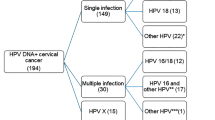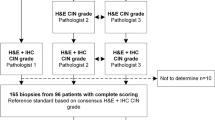Abstract
High risk types of human papillomavirus (HPV) are agents in the aetiology of cervical carcinoma. The products of two early genes, E6 and E7, appear to be the principal transforming proteins. Studies of various monolayer cell culture systems have shown that the E7 oncoprotein of human papillomavirus type 16 is able to neutralize or bypass the inhibitory effect of the cell cycle-dependent kinase (CDK) inhibitors (CKIs) p21WAF1/CIP1 and p27KIP1. To understand whether the p21WAF1/CIP1 or p27KIP1 neutralization also plays a role in vivo, we performed studies on clinical specimens. Forty-five cervical biopsies, including HPV-negative mucosa, HPV 16-positive preinvasive (low and high grade lesions) and invasive neoplasia as well as HPV 6-positive condyloma acuminatum were analysed by single and double immunohistology. We examined the positive cell cycle regulator cyclin A and the universal cell cycle marker Ki67 as well as the negative cell cycle regulators p21WAF1/CIP1 and p27KIP1. Here, we show that in a significant fraction of cells the G1 block can be overcome despite high levels of CKIs in HPV lesions. This phenomenon, which was more evident for p21WAF1/CIP1 than for p27KIP1 was most marked in low grade lesions and in condylomata acuminata, in which a high viral productivity is expected. These results indicate that the overriding of CKI inactivation by viral oncoproteins appears to be a conserved property between low and high risk HPV types. We conclude that the CKI neutralization by HPVs is likely to be required for viral DNA replication rather than for malignant transformation of the host cell.
This is a preview of subscription content, access via your institution
Access options
Subscribe to this journal
Receive 50 print issues and online access
$259.00 per year
only $5.18 per issue
Buy this article
- Purchase on Springer Link
- Instant access to full article PDF
Prices may be subject to local taxes which are calculated during checkout








Similar content being viewed by others
References
Beijersbergen RL and Bernards R. . 1996 Biochim. Biophys. Acta 1287: 103–120.
Blanton RA, Coltrera MD, Gown AM, Halbert CL and McDougall JK. . 1992 Cell Growth Diff. 3: 791–802.
Byrne C. . 1997 Bioessays 19: 691–698.
Cheng S, Schmidt-Grimminger D-C, Murant T, Broker TR and Chow LT. . 1995 Genes Dev. 9: 2335–2349.
Chinery R, Brockman JA, Peeler MO, Shyr Y, Beauchamp RD and Coffey RJ. . 1997 Nature Med. 3: 1233–1241.
Davies R, Hicks R, Crook T, Morris J and Vousden K. . 1993 J. Virol. 67: 2525–2528.
Demers GW, Espling E, Harry JB, Etscheid BG and Galloway DA. . 1996 J. Virol. 70: 6862–6869.
Di Cunto F, Topley G, Calautti E, Hsiao J, Ong L, Seth PK and Dotto GP. . 1998 Science 280: 1069–1072.
Dürst M, Glitz D, Schneider A and zur Hausen H. . 1992 Virology 189: 132–140.
Dyson N, Howley PM, Münger K and Harlow D. . 1989 Science 243: 934–937.
El-Deiry WS, Tokino T, Velculescu VE, Levy DB, Parsons R, Trent JM, Lin D, Mercer WE, Kinzler KW and Vogelstein B. . 1993 Cell 75: 817–825.
El-Deiry WS, Tokino T, Waldman T, Oliner JD, Velculescu VE, Burrell M, Hill DE, Healy E, Rees JL, Hamilton SR, Kinzler KW and Vogelstein B. . 1995 Cancer Res. 55: 2910–2919.
Fredersdorf S, Milne AW, Hall PA and Lu X. . 1996 Am. J. Pathol. 148: 825–835.
Fredersdorf S, Burns J, Milne AM, Packham G, Fallis L, Gillett CE, Royds JA, Peston D, Hall PA, Hanby AM, Barnes DM, Shousha S, O'Hare M and Lu X. . 1997 Proc. Natl. Acad. Sci. USA 94: 6380–6385.
Funk JO, Waga S, Harry JB, Espling E, Stillman B and Galloway DA. . 1997 Genes Dev. 11: 2090–2100.
Gissmann L, de Villiers EM and zur Hausen H. . 1982 Int. J. Cancer 29: 143–146.
Herwig S and Strauss M. . 1997 Eur. J. Biochem. 246: 581–601.
Hickman ES, Picksley SM and Vousden KH. . 1994 Oncogene 9: 2177–2181.
Hiyama H, Iavarone A and Reeves SA. . 1998 Oncogene 16: 1513–1523.
Howley PM. . (1996). In: Fundamental virology. Fields BN, Knipe DM and Howley PM (eds).. Lippincott-Raven Publishers: Philadelphia, PA. pp. 947–978.
Hu TH, Ferril SC, Snider AM and Barbosa MS. . 1995 Int. J. Oncol. 6: 167–174.
Jones DL, Alani RM and Münger K. . 1997 Genes Dev. 11: 2101–2111.
Kaghad M, Bonnet H, Yang A, Creancier L, Biscan J-C, Valent A, Minty A, Chalon P, Lelias J-M, Dumont X, Ferrara P, McKeon F and Caput D. . 1997 Cell 90: 809–819.
La Thangue NB. . 1994 Trends. Biochem. Sci. 19: 108–114.
Macleod KF, Sherry N, Hannon G, Beach D, Tokino T, Kinzler K, Vogelstein B and Jacks T. . 1995 Genes Dev. 9: 935–944.
Mandal M, Bandyopadhyay D, Goepfert TM and Kumar R. . 1998 Oncogene 16: 217–225.
Münger K, Werness BA, Dyson N, Phelps W, Harlow E and Howley PM. . 1989 EMBO J. 8: 4099–4105.
Pagano M, Pepperkok R, Verde F, Ansorge W and Draetta G. . 1992 EMBO J. 11: 961–971.
Pines J and Hunter T. . 1990 Nature 46: 60–763.
Pines J. . 1995 Adv. Cancer Res. 66: 181–212.
Polyak K, Lee M-H, Erdjument-Bromage H, Koff A, Roberts JM, Tempst P and Massague J. . 1994 Cell 78: 59–66.
Ruesch ML and Laimins LA. . 1997 J. Virol. 71: 5570–5578.
Scheffner M, Werness BA, Huibregtse JM, Levine AJ and Howley PM. . 1990 Cell 63: 1129–1136.
Schmidt-Grimminger D-C, Wu S, Jian Y, Broker TR and Chow LT. . 1998 Am. J. Pathol. 152: 1015–1024.
Schulze A, Mannhardt B, Zerfass-Thome K, Zwerschke W and Jansen Dürr P. . 1998 J. Virol. 72: 2323–2334.
Tommasino M, Adamczewski JP, Carlotti F, Barth CF, Manetti R, Contorni M, Cavalieri F, Hunt T and Crawford L. . 1993 Oncogene 8: 195–202.
Xiong Y, Hannon GJ, Zhang H, Casso D, Kobayashi R and Beach D. . 1993 Nature 366: 701–704.
Zehbe I, Sällström JF, Evander M, Edlund K, Wadell G and Wilander E. . 1996 Diagn. Mol. Pathol. 5: 206–213.
Zehbe I and Wilander E. . 1997 J. Pathol. 181: 270–275.
Zerfass-Thome K, Zwerschke W, Mannhardt B, Tindle R, Botz JW and Jansen-Dürr P. . 1996 Oncogene 13: 2323–2330.
Zerfass-Thome K, Schulze A, Zwerschke W, Vogt B, Helin K, Bartek J, Henglein B and Jansen-Dürr P. . 1997 Mol. Cell. Biol. 17: 407–415.
zur Hausen H. . 1986 Lancet 2: 498–491.
zur Hausen H and de Villiers EM. . 1994 Annu. Rev. Microbiol. 48: 427–447.
Acknowledgements
We are grateful to Professor H zur Hausen for his continuous interest in our work and for kindest support. We thank Professors P Bannasch and D Komitowski for a friendly atmosphere while using their laboratory facilities, and Mrs I Schuster for cutting the sections. We further thank Dr J Pines for the cyclin A antibody, Dr L Ringrose for language review, Dr W Rittgen for the statistical analysis, Professor L Gissmann and Dr P Jansen-Dürr for stimulating discussions. This work was supported by a postdoctoral fellowship of the Swedish Medical Society (Svenska Lákaresállskapet), Stockholm, Sweden to Ingebord Zehbe, and by postdoctoral fellowship of Von Humboldt Stiftung to Marianna Alunni-Fabbroni.
Author information
Authors and Affiliations
Rights and permissions
About this article
Cite this article
Zehbe, I., Rätsch, A., Alunni-Fabbroni, M. et al. Overriding of cyclin-dependent kinase inhibitors by high and low risk human papillomavirus types: evidence for an in vivo role in cervical lesions. Oncogene 18, 2201–2211 (1999). https://doi.org/10.1038/sj.onc.1202549
Received:
Revised:
Accepted:
Published:
Issue Date:
DOI: https://doi.org/10.1038/sj.onc.1202549
Keywords
This article is cited by
-
Cyclin-dependent kinases and CDK inhibitors in virus-associated cancers
Infectious Agents and Cancer (2020)
-
The immortalizing and transforming ability of two common human papillomavirus 16 E6 variants with different prevalences in cervical cancer
Oncogene (2010)
-
Human Papilloma Virus (HPV) and Host Cellular Interactions
Pathology & Oncology Research (2008)
-
Presence of papillomavirus sequences in condylomatous lesions of the mamillae and in invasive carcinoma of the breast
Breast Cancer Research (2004)
-
Quercetin elevates p27Kip1 and arrests both primary and HPV16 E6/E7 transformed human keratinocytes in G1
Oncogene (2003)



